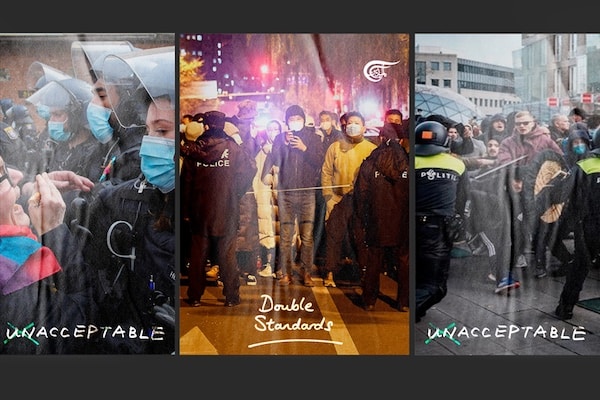In the two years since the World Health Organization declared the beginning of the COVID-19 ‘Pandemic’, anti-lockdown protests around the world have been routinely demonized by corporate media outlets.
Regularly lambasted as being ‘organized by the far-right’ and ‘super-spreader’ events, protests against lockdowns and vaccine mandates have also drawn a brutal state response in a number of Western countries, including Germany, Holland, and perhaps most notably, Canada.
In January 2022, following Ottawa’s decision to impose a vaccine mandate on truck drivers re-entering the country from the U.S., the world’s largest land border and a vital component of the Canadian economy, a nationwide Freedom Convoy would commence in the second-largest country on the planet.
In response, the government of Justin Trudeau—previously mooted by the World Economic Forum as one of its ‘Young Global Leaders’—would respond in an authoritarian fashion, freezing the bank accounts of protest organizers and attacking demonstrators using mounted Horses and teargas canisters.
Therefore, onlookers were bemused this week by Trudeau’s declaration of support for anti-lockdown protesters in China, currently demonstrating against Beijing’s ‘zero-COVID’ policy.
Indeed, this was a view echoed by the western media in lockstep, less than a year after the same outlets were condemning European and American demonstrators for carrying out the exact same actions.
To understand the sudden change in attitude toward anti-lockdown campaigners by the corporate press, one must first look at other events that also occurred in January of this year.
During the same week as the World Economic Forum’s virtual Davos Agenda event, the two-year ‘Pandemic’ narrative collapsed almost instantaneously in multiple western countries. including Ireland and Britain. The WHO, a body with a known record of corruption and ties to pharmaceutical giants, would also call for the ending of all travel restrictions during the same period.
In a further coincidental timing, a week after the Davos event, Hungarian business magnate and Open Society founder George Soros would give a speech to the Hoover Institution in the United States, outlining his view of CCP Chairman Xi Jinping as being the ‘greatest threat that open societies face today’ and predicted that widespread opposition to the Chinese leader’s ‘zero-COVID’ policy would eventually lead to his removal from office. It would be a view that Soros would again express during his address at the World Economic Forum’s Davos summit in May of this year, and indeed, it is a situation that is now playing out in real-time.
On November 24, minor anti-lockdown protests that had begun at the start of the month following the decision by the southern Chinese city of Guangzhou to re-impose restrictions would grow exponentially in the aftermath of an apartment fire in the north-western Xinjiang province, leading to the deaths of ten residents, with lockdown restrictions being blamed on preventing firefighters from reaching the scene.
In a classic color revolution style, the “A4 Revolution” has been given coordinated sympathetic coverage by the mainstream media, similar to the 2013 Euromaidan Ukrainian regime change operation, in which the Open Society Foundations also played a key role. What has been given less coverage, however, is the decision by Chinese authorities to listen to the legitimate grievances of anti-lockdown protesters and subsequently remove restrictions in Guangzhou and the city of Chongqing, the focus shifting to the wider demand for the removal of Xi Jinping’s leadership instead.
Indeed, this was echoed in an article supportive of the protests by the National Endowment for Democracy, a Reagan-era Neoconservative foundation that effectively acts as a privatized version of the CIA, fomenting regime change from Libya, to Belarus, and now, using anti-lockdown protests that would have been widely condemned less than a year ago, China.

